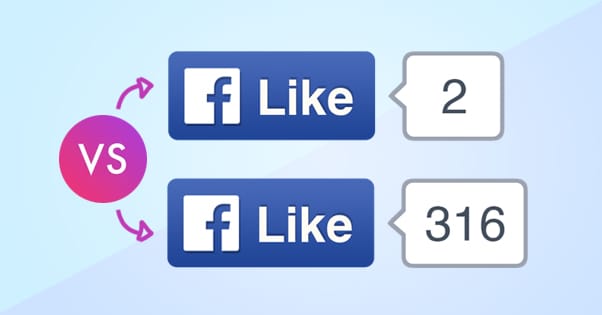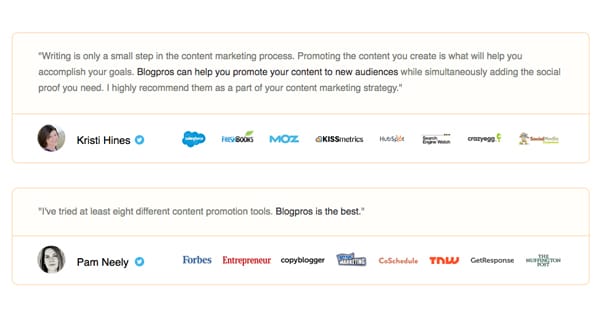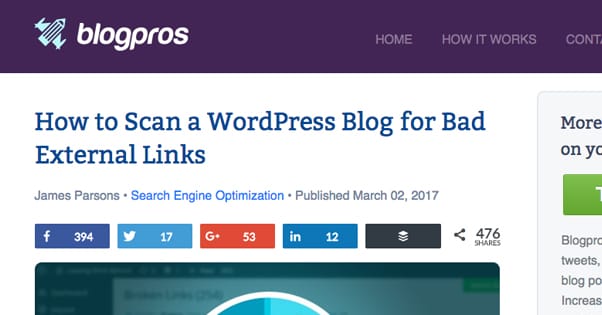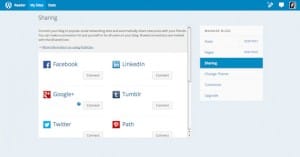Why Social Proof is Important for Your Blog Posts
Published by Kenny Novak • Social Media • Posted March 25, 2017 ContentPowered.com
ContentPowered.com
Social proof has been leveraged for as long as there have been people trying to sell items to a crowd, and crowds to buy them. Sometimes it’s blatant, overt, and other times it’s subtle. With internet marketing, it has simply become codified and easy to implement.
Think about it like this: you see two restaurants, both opening the same day. One of them has a line that loops around the block. The other is pretty much empty. They serve similar food, so which do you go visit?
Personally I’m a contrarian so I’d visit the empty one, but that’s more because I hate waiting in line more than I hate bad food. Most people are going to opt for the busy restaurant, under two assumptions. The first is that “that many people can’t be wrong.” The second is that the empty restaurant must be doing something wrong, otherwise it would have plenty of business as well.
If you port this idea to blogs, imagine Facebook follower counts. If two marketing blogs with similar content exist, which do you read? The post with 10 likes or the one with 300?
In reality, you can easily read both, and in fact the smaller one might be better, you just wouldn’t have known about it without all of the shares social proof can bring.
Why Social Proof?
Think about your life. When you go to make a purchase – something moderate or large, like a computer part, a vehicle, or something similar – what do you do? Most people start by gathering information. They look up the various options available for that product, they read reviews for that product, they ask their friends about the product options. As of four years ago, 79% of customers read online reviews and trust them as much as personal recommendations.
Humans are social, herd animals. We trust each other to make good decisions, even though we probably shouldn’t. When we see a lot of people buying a product, we assume there’s something valuable about it.
When most of the people buying that product leave positive reviews about it, we trust those reviews, and we’re more likely to buy that product ourselves.
As marketers, we can take advantage of this to get more people to convert. By showcasing how many people like our brands and products, we can make other people more likely to opt in.
The Five Types of Social Proof
Social proof is the wisdom of the herd, but it can be divided amongst different categories. You’ve seen them all, I’m sure.
1: Friends and Family. This is the social proof of direct recommendations from friends, family, and anyone close enough to you that you trust their opinions over those of a stranger. Facebook loves to leverage this by showing you which if your friends have liked a page you’re looking at.
2: Bulk Wisdom. This is the social proof of the sheer quantity of people who have purchased or used a product. McDonalds made this famous with their counter of people served – long in the billions – but it’s common everywhere. Every website that displays the number of visitors to their site with a hit counter is leveraging this kind of social proof.
3: User Proof. This is small-scale social proof from individuals. These are the reviews of products you see on Amazon, primarily. It can be anything from a simple review to a case study or video of personal experience with the product. In this case it’s not bulk that lends trust to the proof, it’s the earnest honesty of the review.
4: Celebrity Proof. This is the same as user proof, but the user in question is a celebrity, someone famous. This is why so many commercials for services and products on TV pay for celebrity endorsements. People who want to be more like their favorite celebrities will trust those endorsements and buy those products.
5: Expert Proof. This is the same as celebrity proof, except it’s not “this football player is endorsing this computer game” level of abstraction. Instead, it’s someone who is known for being an expert giving you their expert opinion. It’s like when Neil Patel or Rand Fishkin recommends a piece of marketing software; marketing is their industry, so they know what they’re talking about, and you trust their recommendation.
Not every site will be able to leverage every form of social proof. Amazon, for example, rolls primarily with friends and family proof, bulk wisdom, and user proof. They don’t care so much about celebrity or expert proof, because they don’t need to. Conversely, many web services will go with user proof and expert proof, showcasing testimonials and case studies as well as recommendations from high profile industry experts.
Leveraging Social Proof
Different sites can use different kinds of social proof, so I’m going to go down a list. If you can implement one type or another, do so. If not, don’t worry about it; as long as you have something, it will benefit you.
Testimonials are some of the easiest forms of social proof to implement. The idea is that someone who has used your product or service leaves a detailed recommendation. This recommendation might be on a third party site like Yelp, Quora, or Amazon, or it might be directly on your site. Obviously, you want positive testimonials, so you need to solicit them. It’s a fact that users are more likely to leave a review when they’re displeased, because pleased users don’t think about it. You need to implement a system of email follow-ups to ask users if they have any customer service questions, or if they would like to leave a review.
You can leave small testimonials on landing pages and on product pages, and you can have a rotating box of them on a sidebar. You can encourage positive testimonials on third party sites as well. People who are interested in your product will find them, your goal is simply to make sure they exist.
Reviews are like testimonials, but with less authority behind them, less trust in them individually, and more of a variety of possible ratings. Typically you’ll want to simply establish a public review system, so users can come leave reviews right there on your site. Amazon is the best example of this in action; anyone can leave a review for anything. Newegg has an additional twist, in that they have a “verified purchaser” flag for reviewers, to make sure they actually have the product they’re reviewing, to prevent false reviews. You want these in bulk, particularly for an aggregate reading, but also so that you can address trends in customer service or product issues. Reviews are an opportunity to reach out to those people having issues and help fix them.
Endorsements are testimonials from specific, high-influence users. Using these is a matter of putting them in a prominent position on your site. I like to send out trial versions of products or coupons for services to entice specific influencers into trying out what I’m offering. Anyone who uses your product can submit a testimonial, but you’re looking for the people with highly relevant audiences in your industry.
Whenever someone with the proper level of influence leaves a review, writes a testimonial, or even just writes a blog post where they mention using your product, you can reach out and ask them if they would be willing to write a testimonial you can use on your site. If they do, you can then place it in a prominent position. Your homepage, your landing page, or some other highly visible location will do nicely.
Use badges are indications of clients that use your service, badges of approval, seals of trust, and mentions.
- You can place badges of high profile sites and lists your site has been mentioned on, like if you have a high rating with the BBB or if you’ve been placed on the Inc top 500 list or a Forbes list.
- You can, on a similar note, post the logos of any high profile media companies that have reviewed or mentioned you. You see this a lot on IndieGoGo and Kickstarter campaigns these days; if your campaign has been mentioned on Wired, on Mashable, on the Wall Street Journal, or on any other major blog, you can include that logo. Just make sure you’re using recognizable logos, rather than the logo spam from PR companies and private blog networks.
- You can place security badges, like the Truste certification, the Paypal verification, and the VeriSign badges, on pages where security matters. They go best on payment info pages and registration pages.
- You can use the logos of high profile brands that use your service. This will depend on your actual client list, of course, but it’s very common with CRM services and marketing apps these days.
Don’t go overboard with the logos; it’s better to have five high quality badges than it is to have 50 badges for sites no one has ever heard of before.
You can make use of subscriber counts in two ways; through social media and through raw counts.
With raw counts, you often see this used with email newsletters. People are more likely to sign up for a mailing list if they know they’re getting value out of it, and one way to know there’s value in the newsletter is by knowing that thousands of other people are using it. “300,000 of your peers read our newsletter every day” is a good way to get people to register. Of course, you can’t lie about your subscription numbers, even though there isn’t much way to verify. People expect a certain level of awareness out of it.
With social media, you get this through social sharing buttons.
You can get whole-site social proof with something like the Facebook like box, which shares the total number of people who have liked your page, along with some targeted social encouragement to the users who are viewing the box. It shows their friends mixed in to the crowd, if any of their friends already like your page.
Likewise, you can use social sharing buttons to accumulate social share counts for your posts, which can give you a boost in getting those posts read and shared further. It’s been made more difficult over the last year or two with Facebook and Twitter removing the share count access to their third party API, but you can recover them in some cases. In other cases, you can use a derived metric, like the Mashable velocity graph or the Business Insider heat rating. Both will give a bit of social proof without necessarily showing individual metrics.
You can also use data as a sort of social proof, if you have a service that relies on specific metrics. For example, Google always shows you the number of results for a search and the time it took to run that search, even though it’s always a fraction of a second and pretty much no one cares about anything past the first page. A data center will show you their historical uptime. Any company can showcase their turnaround time for customer support. These are all elements of trust you can leverage to build more trust in your brand as a whole.
One thing you should always avoid is negative social proof. Negative proof is when you make a claim but then try to support it with a negative statement. How many people care about the “This year, Americans will produce more pollution than ever before” campaigns? The problem is not that there’s a negative thing happening, it’s that you’re trying to say it’s really bad and then say that everyone is doing it. You’re giving bulk social proof to the wrong thing.
Like I said; you can’t use every form of social proof on your site. You’ll likely only fit two or three of them. Testimonials, badges, and reviews all work well together for just about everyone, and the rest can be added in if you can swing them.









